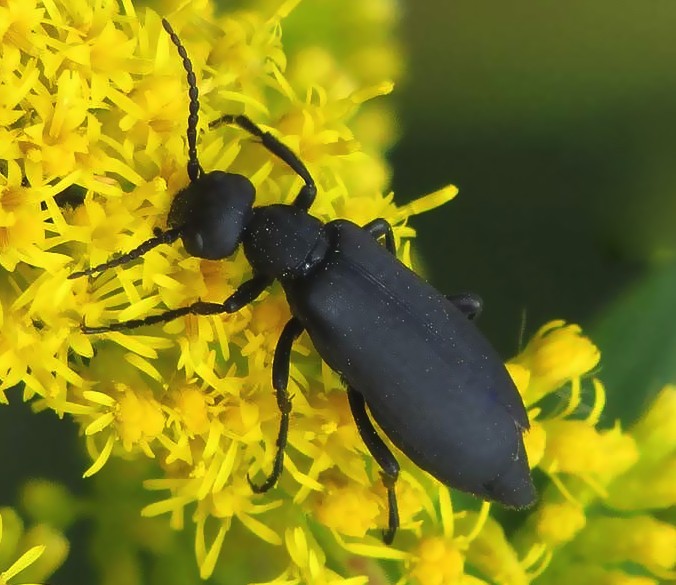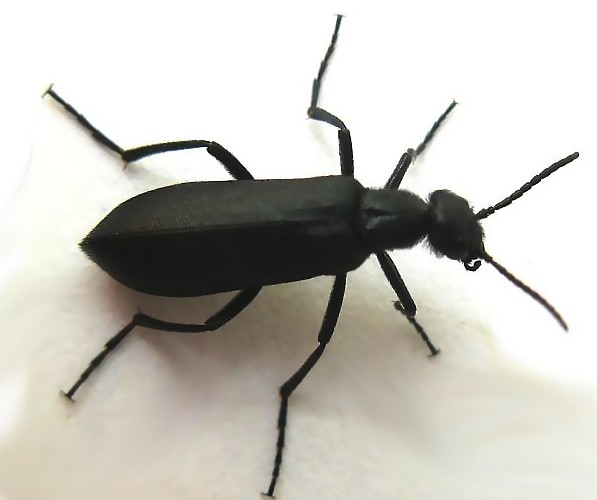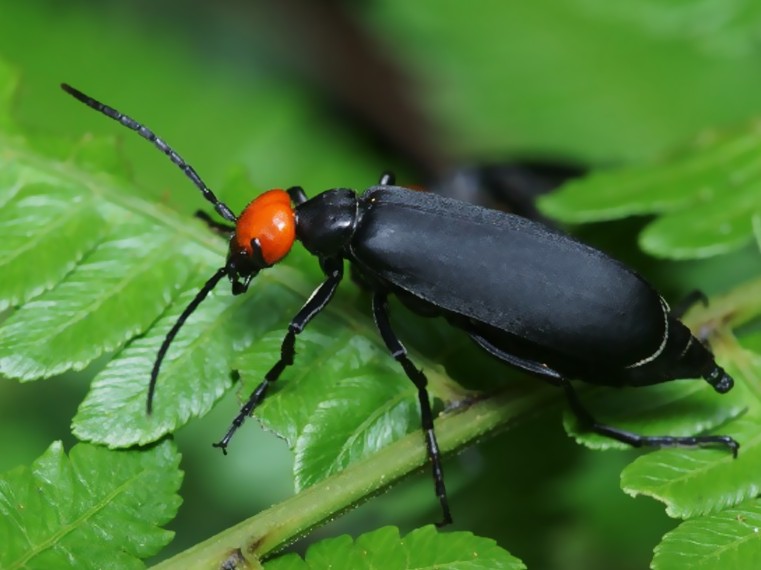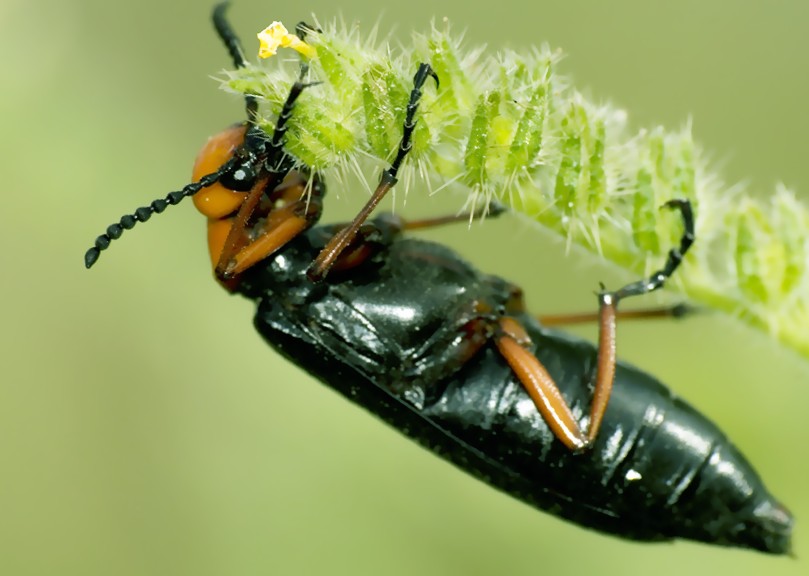Blister Beetle
What is a Blister Beetle?
A blister beetle is a common and brimming field and garden pest that comprises venom. If ingested, it can severely injure domestic animals. These creatures are well-known for the welt-raising discharge that they emit when they’re crushed or injured. This secretion consists of a blistering agent, which is known as cantharidin – a substance that is used for treating the lesions caused by the pox virus.

Picture of a Blister beetle
Cantharidin is poison and causes harm if ingested. It endured in dead bristle beetles long after the hay (infested by these critters) not only has been dried but baled as well. Horses are vulnerable to poisoning. Of course, it depends on the beetle type that four to six grams of dead insects can be fatal.
Blister beetle – a common name for soft-bodied (usually brown or black in color) – are mainly extended and cylindrical insects that belong to the Meloidae family. These bugs are commonly found feeding on the flowers and a variety of plants.
Being vegetarians, blister beetles have a weakness for flowers of plants, including legumes, sunflowers, and plants. They infrequently feed on the leaves, but the flowering parts are what they’re highly fondly of.
Found mainly in the Midwest and southwest regions of the U.S., these creatures are extremely poisonous when they are swallowed by horses. Maybe five to ten of these beetles are deadly to a horse when ingested. Even though these critters contain a very powerful toxic substance, they don’t spread this venom through biting.
Blister beetles from time to time are seen on garden plants or native plants in large gatherings. If you happen to have an encounter with these critters in the wild, they definitely make an amazing insect specimen for collection, but make sure you are careful when handling them.
Appearance and Size

Many species of blister beetles are native to the United States. Horse owners are especially concerned about these creatures. They are recognized by their medium to large size, which is generally 1-2 cm. These insects differ by species in size and have a rectangular head and plump abdomen with leathery wings.
One of the unique features of blister beetles is that the pronotum is slender. It’s narrower than the head or the abdomen’s front edge. However, there are some species of blister beetles, especially in the Western part of the United States which are vibrantly colored, but the ones found in the eastern U.S. are black or dull colored.
The majority of these beetles are long with a narrow body. Their wing covers are not only soft but are flexible. Even though there are more than 100 species in Texas, some of the most common beetles consist of the black blister beetle, E.occidentalis (east and central Texas) and many more.
Not only do these blister beetles have broad-heads, but they also have long (3/4 to 1-1/4 inch) and narrow bodies. Their antennae are about 1/3 the length of their bodies.
Habitat
Blister beetles consume alfalfa and other blossoming plants. These creatures are normally found in areas with a frequent occurrence of grasshoppers. While this critter can cause harm to alfalfa crop of a farmer, especially when there is a bevy of blister beetles, the major concern is the adverse effect they have on farm animals, especially horses. If cantharidin is ingested, it can make the animal’s urinary and gastrointestinal tracts worse.
What Do Blister Beetles Eat?
Mouthparts are for munching. The species of blister beetles eat flowers and bushes of diverse crops, including:
- Soybeans
- Garden Vegetables
- Alfalfa
- Potatoes
- Ornamental Plants

Picture of a blister beetle feeding on plant leaves
Immature and young blister beetles consume the eggs of a grasshopper and live in isolated beehives or are predaceous, (of course) depending on species. Adult blister beetles can be found feeding on the infested crops or flora. Make sure you don’t deal with blister beetles that are preserved in alcohol. This is because the cantharidin liquefies in alcohol and cause swelling on one’s skin.
Are Blister Beetles Poisonous?
Blister beetles have consistently been used in medicines in the past. Dead as well as dried beetles were crushed into a fine powder, which was used for creating a potion known as ‘Spanish fly’. People used this concoction for treating health-related problems, including arthritis. The beetles use cantharidin as a way to protect themselves and their eggs. They unleash this chemical when attacked by predators.
Cantharidin is a toxic chemical that causes swelling or irritation. When Spanish fly is consumed, it causes irritation to the urinary tract, which can further give rise to sexual stimulation. Aside from the obvious benefits, cantharidin is also known to have serious medical problems. In fact, it is extensively considered as a poison. It can lead to diarrhea, kidney failure, internal bleeding, and death.
Symptoms of poisoning include:
- Nausea
- Vomiting
- Stomach Pain
- Coma
- Bloody Urine
If a person believes that they have been infected with cantharidin, health care professionals will perform diagnostic tests just to inspect the chemical presence in urine.
Regrettably, there is no direct counteragent available for treatment. However, your doctor may employ oral antipoisoning procedures which include an IV drip and stomach pumping.
Blister Beetle Bite

Living in an area where blister beetles are not uncommon – the central and eastern United States? You are possibly very close to the particular species of insects called blister beetles. Perhaps, you have had a close encounter with this striking insect before. Or, you have been given a warning to prevent yourself from coming in contact with these creatures. Maybe you’ve been hurt by one of these fascinating critters.
No doubt blister beetles can attack humans to cause harm, but there are some myths associated with them and their behavior.
Do Blister Beetles really Bite?
Blister beetles don’t actually bite, but they produce a chemical known as ‘cantharidin.’ These insects don’t have a stinger with which they can deliver this chemical, so they are not capable of releasing a fatal bite. But, the fact remains true that this chemical (cantharidin) can cause form welts or blisters on exposed skin. It can take place when someone smashes this insect crawling on their skin. Blisters don’t take a lot of time to form, but they might take a couple of hours to show their effect on a person’s skin.
Is the Bite of a Blister Beetle Venomous?
Not at all! A lot of people live with an assumption that the creature infused them with some lethal chemical, as they have been bitten. This is usually after they receive swelling on the skin. However, this statement does not hold true. The jaws of this insect (bristle beetle) are not designed to pierce the skin in the way a snake’s fangs are. These insects only transmit cantharidin inside their bodies.
How to Control Blister Beetles
Adult blister beetles eat the leaves at the top of the foliage of the plants. Flowers catch the attention of these insects so that they can feed on the pollen and swallow the nectar. These beetles are very fond of vegetable as well as ornamental plants.
If you’re looking for the most effective way to control these critters, settle for no less than handpicking. But, ensure that you are wearing gloves to defend yourself from the venom. Place them into a container filled with soapy water where they will breathe their last. Or, you can consider shaking a stem over a pan of this (foam-covered) water. Blister beetles will find their way back to the plant in no time if you don’t make sure that they will find themselves in the soapy water.
As well, you can spray them spinosad, which not only is safe but effective considerably. However, the spray must come in contact with the insect’s body. As a result, you probably have to spray a couple of times.
Pictures of Blister Beetles
Take a look at some of the fascinating pictures of blister beetles:



